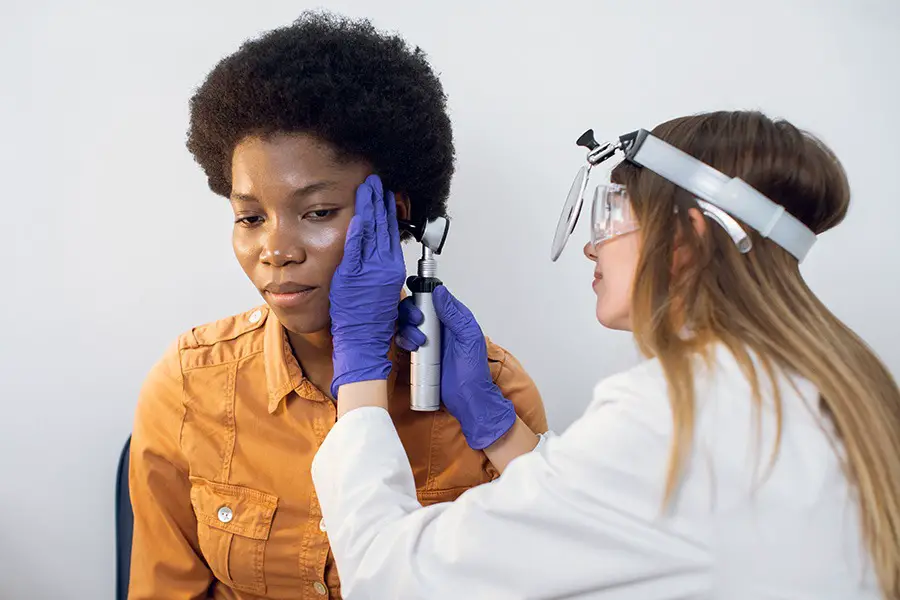Introduction
Auditory perception plays an integral role in a child’s growth, acting as a key to unlocking language skills, communication abilities, and socio-emotional development. Pediatric Sensorineural Hearing Loss (SNHL), the prevalent form of permanent hearing loss, exerts a substantial impact on a child’s developmental journey. This thorough analysis endeavors to explore the intricate dimensions of pediatric SNHL, assessing its effects on child development, the significance of early detection and intervention, as well as the triumphs and trials that characterize this narrative.
Appreciating pediatric SNHL necessitates a comprehension of various elements such as genetics, environmental influences, medical interventions, educational systems, and the child’s resilience. While the path is laden with obstacles, it is equally filled with victories and heartening accounts of children surpassing expectations. This critical analysis aims to provide an in-depth appraisal of pediatric SNHL, enhancing our understanding, and encouraging a more holistic perspective.
The Influence of Sensorineural Hearing Loss on Child Development
The initial years of a child’s life represent an essential phase of swift learning and development. Sensorineural hearing loss presents obstacles in these vital developmental domains. The principal manifestation of this interruption is in language acquisition and speech development delays due to diminished auditory linguistic input. This setback can have cascading effects on cognitive abilities, literacy skills, and academic performance.
In addition, socio-emotional development of the child can be compromised. Children with SNHL often grapple with feelings of isolation and difficulty in engaging with peers due to communication barriers. These complications emphasize the extensive and pervasive influence of SNHL on child development, underlining the urgency for early identification and comprehensive interventions.
Early Detection and Intervention in Pediatric Sensorineural Hearing Loss
Swift identification of sensorineural hearing loss is instrumental in lessening its influence on child development. Newborn hearing screening programs enable detection of many SNHL cases within the first days or weeks of a child’s life. Timely detection paves the way for early intervention, significantly enhancing the child’s language, cognitive, and socio-emotional outcomes.
Nevertheless, the necessity of early detection isn’t universally met, especially in settings with limited resources. Moreover, even when SNHL is promptly identified, there can be delays in rolling out suitable interventions due to systemic problems and resource limitations. These gaps in the provision of detection and intervention services highlight critical improvement areas in addressing pediatric SNHL.
Tweak Digital Hearing Amplifier
Experience the epitome of sophisticated sound with Tweak, the revolutionary device that brings a new dimension to your auditory experience. Harnessing the power of innovative patented technology, Tweak offers you the freedom to fine-tune your hearing with a diverse range of amplification options. Whether you prefer a subtle enhancement or a more pronounced boost, Tweak empowers you to effortlessly customize your acoustic world.
Crafted with meticulous care and expertise, Tweak represents the brilliant collaboration between an esteemed audiologist and a team of dedicated acoustic engineers. Their collective passion for impeccable sound quality shines through in every detail of this remarkable device. Designed to elevate your hearing capabilities across any environment, Tweak utilizes cutting-edge technology to ensure that you can fully engage with the sounds that matter most to you.
Unlock the extraordinary potential of affordable sound quality with Tweak. By leveraging the latest advancements in digital technology, this ingenious device delivers an auditory experience that rivals that of prescription hearing aids. With premium-grade components at its core, Tweak offers you uncompromising performance without breaking the bank. Immerse yourself in a world of enhanced sound, where clarity and richness seamlessly merge to create an exceptional listening experience.
Understanding Congenital Sensorineural Hearing Loss
Congenital sensorineural hearing loss, present from birth, can arise from genetic factors or prenatal exposure to infections or certain drugs. The complex origins of these causes necessitate deeper understanding and further research. Despite the strides made in genetic testing, the cause of congenital SNHL remains elusive in a substantial number of instances.
An exhaustive understanding of congenital SNHL etiology can guide prevention strategies, inform prognosis, and assist in developing targeted interventions. However, the path towards this comprehension is laden with scientific and ethical hurdles, especially in the field of genetic testing and gene therapy.
Pediatric Sensorineural Hearing Loss: Challenges and Solutions in School
Sensorineural hearing loss presents unique challenges for school-age children within educational environments. These difficulties span auditory learning challenges, peer communication, and the educational institutions’ lack of understanding and accommodation. It’s important to consider these problems can augment the academic and social disparities experienced by children with SNHL.
Implementing solutions within school settings demands a multi-dimensional approach, ranging from using assistive listening devices and classroom accommodations to specialized educational programs and services. Equipping teachers and cultivating a supportive and inclusive learning environment hold equal importance. Despite the availability of these solutions, their implementation varies across schools and regions.
Success Stories: Children Overcoming Sensorineural Hearing Loss
Despite the trials associated with sensorineural hearing loss, countless children display incredible resilience and determination. Numerous accounts exist of children with SNHL who, with the aid of early interventions, assistive technology, and educational accommodations, excel academically, flourish socially, and achieve notable success. These stories shine a light on the potential outcomes when barriers are removed and appropriate support is in place.
These success stories, while uplifting, should be viewed not as exceptions, but as achievable outcomes. They underscore the need for comprehensive support systems and the transformative power of resilience, thereby strengthening the argument for widespread, equitable access to interventions and resources for children with SNHL.
Conclusion
Examining pediatric sensorineural hearing loss through an academic lens facilitates a more profound understanding of the intricate interplay between the condition, the child, and the environment. The investigation clearly expresses the pervasive impact of SNHL on a child’s development and the significance of early detection and intervention. It also emphasizes the systemic and logistical challenges in implementing school-based solutions and the resilient spirit of children navigating these challenges.
Nonetheless, there are significant gaps, especially in understanding and managing congenital sensorineural hearing loss. While advancements in genetics provide some insights, the etiological mystery of many cases persists. Coupled with the ethical dilemmas surrounding genetic interventions, this mystery provides abundant material for future research and policy debates.
It’s also crucial to recognize the significant variation in the experiences and outcomes of children with SNHL, a reminder of the role of individual resilience and systemic support. The inspiring stories of children overcoming sensorineural hearing loss should serve as compelling motivators for expanding access to early interventions, assistive technology, and supportive educational environments.
In conclusion, pediatric sensorineural hearing loss remains a complex, multi-faceted challenge that necessitates a collaborative, holistic approach for effective addressing. From researchers and healthcare professionals to educators and policymakers, each stakeholder plays a critical role in shaping the narrative of pediatric SNHL. This exploration highlights the need to enhance our understanding, improve interventions, and foster environments that empower children with SNHL to reach their full potential.
In closing, while this analytical lens brings attention to gaps and improvement areas, it also acknowledges the substantial progress to date. There is room for optimism, albeit tempered with the awareness of the work yet to be done.

Decoding Silence: An Analytical View on the Advances in Conductive Hearing Loss Research and Treatment
This analytical article sheds light on conductive hearing loss, offering an in-depth exploration of its genetic factors, treatment advances, and promising experimental therapies.

Embracing the Melody of Life: Navigating the Journey with Conductive Hearing Loss
A blog post delving into the experiences and challenges of living with conductive hearing loss, discussing its impact on everyday life, social interactions, mental health, and the potential benefits of hearing aids and cochlear implants.





